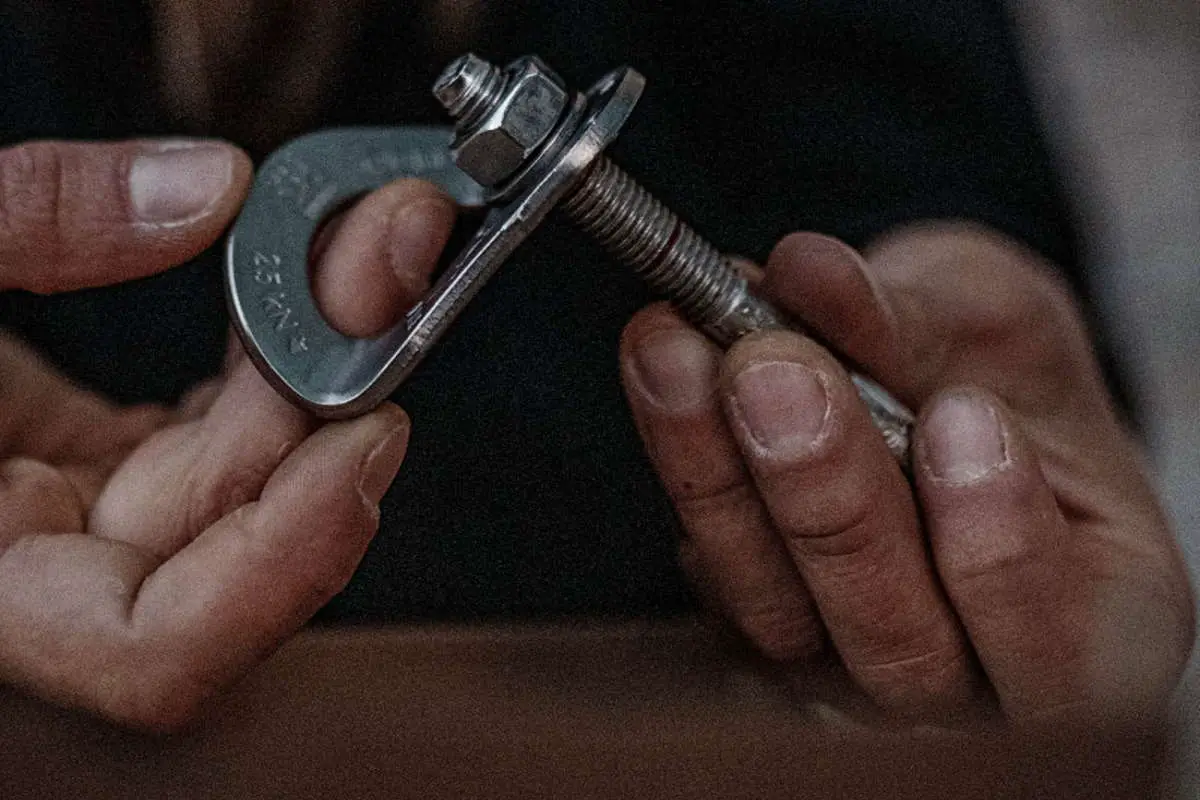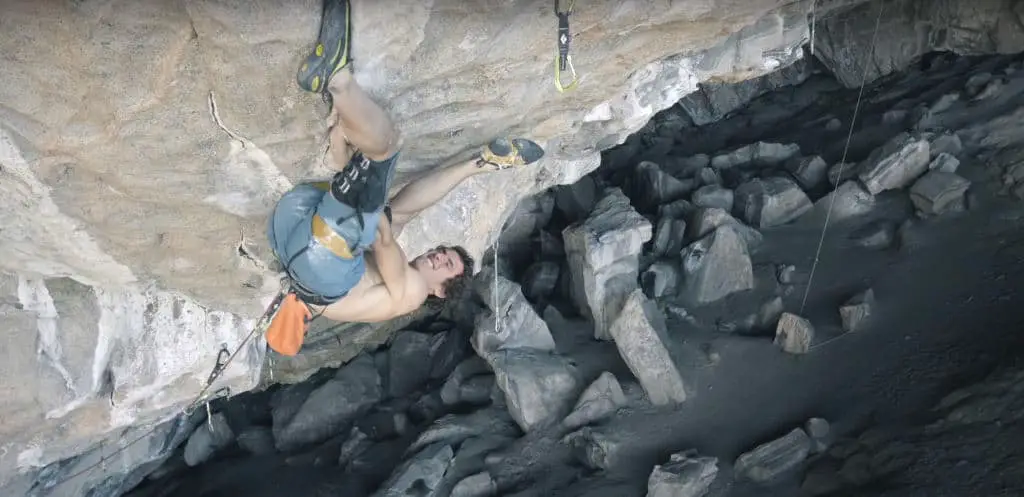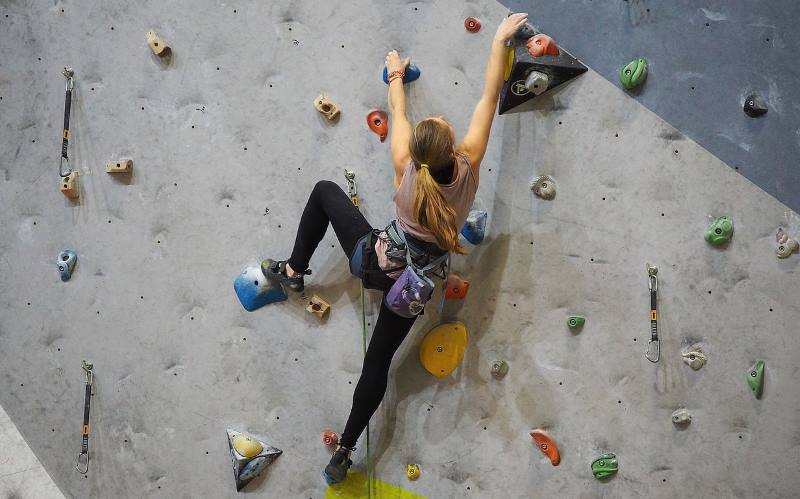Trad Climbing is a form of climbing that feels like a real adventure. With only technique, gear, and skills, you and your partner tackle a wall with no extra help. The risk is real and it’s up to you to make every decision.
While Sport Climbing is probably the most popular form of climbing these days, Trad aka traditional climbing is where the modern trend started. While you might learn to top rope and lead in a gym before heading out, Trad allows you to climb wherever you like – free of the restrictions of bolts.
What Is Trad Climbing?
Trad Climbing is the more traditional form of rock climbing where the protection from falling is placed into the wall by the climber. As a climber ascends they place pieces of gear – like cams or nuts – into faults in the rock, then clip their rope into carabiners that are also clipped to the gear.
If a climber falls then the gear they’ve placed should hold, and the partner below will catch their fall on the rope. So for Trad that means knowing how and when to place gear, and knowing the right kind you’ll need is very important. Learning Trad is like an apprenticeship, it takes time and input from others with experience.
Why Is It Called Trad Climbing?
It’s called Trad simply because it’s more “traditional”. The names for style of climbing are a bit odd as things have evolved quite a bit over the years. Trad climbing used to be the given style for a long time and if someone said they were going climbing they meant Trad.
Then Sport Climbing started to introduce a radical new way of protection from falls, and the name Trad was needed for the now older style. Climbers started to drill metal bolts and hangar into walls every few meters, allowing climbers to simply clip in without carrying or placing gear.
- Aid Climbing – Placing gear into a rock face and pulling on that gear itself to get up.
- Free Climbing – This includes Sport and Trad Climbing. The “free” part means using the gear only for protection. Climbers should climb the rock themselves without pulling on gear, just using their technique and strength.
- Trad Climbing – Free Climbing using gear placed while climbing the route. Falling can pull the protection out of the wall.
- Sport Climbing – Free Climbing using metal bolts and hangars that are already pre-placed in the wall for protection. Falling is fairly safe as bolts rarely fail.
Want to learn more? Read our climbing jargon explained articles
What Is Free Climbing? – What Is Sport Climbing? – What Is Bouldering? – What Is Free-Soloing?
What Gear Is Used In Trad Climbing?
Trad is all about the gear and using it properly. A Trad climber’s gear will normally include a range of cams, nuts, slings, quickdraws, and spare carabiners. People tend to either have a large range of gear and figure out what they need for a specific climb – or have gear specific to one area.
Either way, Trad climbing gear can be expensive. Getting your first rack together can be a bit daunting but take a look at our guide below for help. What will be most helpful is to figure out where you’ll climb most and chat to other climbers to see what they think are the must-haves.
Active Protection – Cams
Cams or spring-load camming devices (SLCD) are clever devices that squeeze down small with a trigger pull, that then allows them to be pushed into a crack, then released. The two lobes then actively push out against the rock with a camming (rotational expanding) force. If all of the lobes are touching rock and the cam is around the middle of its movement, cams are excellent protection.
In a fall the lobes then actively push against the rock with a spring, increasing their holding force. This means cams are great for either parallel cracks, or where the crack expands or flares outwards. You can get a wide variety of cams that are more suited to different rock types. They are complicated devices that require a lot of testing in their design and do cost a fair bit.

A single cam can cover a range of different placement sizes, and there are a huge range of cam sizes – with the upper and lower ends being the weakest. Most Trad Climbers have a range of sizes and sometimes double or triple up on the same sizes.
In certain areas where there are splitter cracks the full length of a cliff, you might need multiples of just one or two sizes. You can also get offset sizes where one set of lobes is larger than the other, which can be excellent for placing in pockets or pin scars.
Passive Protection – Nuts, Hexes, Tricams, Big Bros
Climbing nuts are the foundation of most Trad racks and were the first pieces used in modern Trad. They’re a single piece of metal slung with a sturdy wire and feature no moving parts. They’re simple to use and when placed correctly can be absolutely bombproof.
Nuts typically have at least one flared side, sometimes two, and can also be curved. When used in a constricted placement – where the inside of the crack is larger than the outside, or the bottom of the crack is thinner than the top – they can be moved about and “set” with a few tugs until they fit snugly in the placement.
The advantages of nuts are that they are cheap, light and easy to carry a large range, and can be as small as 3 or 4 millimeters or 5/32 inches. Nuts are sometimes called chocks, from when natural stones were used like nuts, wedged into cracks and slung – known as chockstones. Nuts are also known as wires or stoppers.
The name comes from when steel nuts – that are screwed on to bolts – were used. Climbers like Joe Brown would pick up disuses railway nuts, drill out the sharp thread in the middle to smooth out the hole, then sling them with fabric. Things have evolved greatly since then but some of the hardest classics were climbed with this type of gear.

Larger, hollow nuts with six are called hexes (after hexagon) and are used in larger placements than nuts. They can be passive with the wire pulling down, or placed semi-actively. The six sides give three different size for placing. They’re less used now as cams fill a similar role but are much cheaper, with larger sizes lighter than the equivalent cam.
Tricams are much-loved by certain climbers. They can be used passively as nuts, as well as having active placement in their design. They manage to stay fairly cheap but offer extra options in between a cam and a nut, and offer more range than just a nut.
Big Bros are an interesting bit of trad gear that really only work in one situation. Wide crack climbs where you can shove most of your body in are notoriously hard to protect. The big bros are heavy, chunky cylinders that slide down to a small size on your harness, then are screwed out and locked to size in the crack.
Slings, Quickdraws + More
Having a few dyneema or nylon slings handy is essential for a lot of trad climbing. A couple of shorter and a couple of longer slings are on most people’s rack depending on the area climbed. These can also be called runners or webbing.
They’re used for a variety of purposes but mainly for keeping rope drag low by extending a placement on a bit of gear. You can also sling them over a rock or through a hole, then clip in to them as a piece of protection, or for making an anchor or rappel point.

Extending a placement is needed when you place a bit of protection far out to the left or right or deep into the rock. To the left or right can create a zigzag in the rope which leads to rope drag that can be problematic the higher you go. Clipping a sling into a cam allows you to extend where the rope lies, leading to a straight line and less drag.
A placement deep in the rock might need to be extended to ensure a fall would pull the gear down and not out. This is also the case with a piece of gear out on the left for example. Protection should always be placed thinking about the direction of the pull as you climb and if you were to fall.
Some people prefer a more rope-like accessory cord, also known as cordelette, for the same purposes. Cord is often used for building an anchor at a belay station, or for setting up a top rope. Cord has the advantage of being stronger than most slings because it is dynamic, meaning it stretches like a normal climbing rope. You can also buy whatever length you’d like and tie the ends together.
Quickdraws in trad are similar to Sport draws but tend to be much lighter to save weight. The carabiners are a little smaller and the dogbone (fabric connecting the biners) is thinner and bendier than a Sport draw. This allows for more flex while climbing, hopefully allowing gear to stay in place.
You can clip a quickdraw into the cam or nut, or sometimes clip directly into the cam’s loop if the situation calls for it. You can also get extendable quickdraws (or make your own) that are just two biners on a wrapped sling. You can then extend the sling by unclipping one biner, pulling through, and re-clipping. This style is often called an alpine quickdraw.
Nut tools are long pokey metal sticks with a hook for pulling or pushing gear in and out to remove it. They’re almost a must-have for seconding in trad climbing or removing any stuck gear. If you use nuts these are a godsend.
Is Trad Climbing More Dangerous?
It depends on the route, the protection, and many other factors – but in general yes, Trad is more dangerous than Sport climbing. The simple fact is that a high quality, climate, and rock appropriate bolt that was placed well should be able to take multiple big falls and last for years without pulling.
Falling on trad is always scarier as there’s always the chance of the piece pulling out because it wasn’t placed perfectly, the gear pulling or walking while you climb, the rock breaking, the force being too much for the gear, a cam breaking, e.t.c.
Where it’s not possible to place gear for a long section, that can lead to big runouts where big falls are possible. The bigger the force, the more likely the piece below pulls. If a piece pulls that creates even more force on the one below which can lead to a “zipper” where multiple pieces pop out!
However, Trad climbers don’t always tend to push their grade limits as much as Sport climbers. Trad is much more suited to longer multi-pitch climbs and big days out so there’s more of a softly softly approach with experience plus local knowledge of the right protection being more important than just numbers.
How To Start Trad Climbing?
The best way to start Trad climbing is to hire a local guide who can dedicate their time to making sure you learn a wide range of skills. They can tailor your experience to the area, figure out what you need to hear the most, and will have a range of gear to give you a taster in.
Getting out with trusted and experienced locals after that is a great way of building up your knowledge. There’s a long tradition of mentoring in Trad climbing and you’ll find every person has something to add to your growing list of Trad tricks.
We’d recommend having a base of climbing skills from indoor or outdoor Sport climbing first. Being confident on easy terrain makes it easier to hang around while slowly placing your first few pieces of gear. The pump gets real when you just can’t get a piece in!
What Are Leads and Seconds In Trad?
The lead climber in Trad is the person going first and placing the gear. The second is the climber that comes up after them, usually while being belayed from above. The second removes the gear, which is called “cleaning” the route. Leading a route is definitely scarier than seconding in most situations however seconding is a great way to learn about gear placements while getting climbing in.
Removing placed gear is a skill in itself, especially when cams are “over-cammed” – the lobes are too constricted and there is barely any room for the cam to expand. Taking a fall or yanking too hard on a nut is also a good way to weld it into place forever.
Leaving gear that won’t budge or if when need to bail can and will happen to most Trad climbers. At that point it becomes climbing booty aka crag swag, or a nice gift to anyone with a bit of patience.
How Do Trad Climbers Get Down?
That depends a lot on the situation, but it’s probably less complicated than you’d think. If you’re brand new to climbing we actually wrote a whole article on it – How Do Rock Climbers Get Down? However, it can be summed up like this: –
- Walking off from the top – Depending on the area, walking down the easy side is pretty common
- Lowering or Rappelling – Just like Sport climbing, you can either be lowered by your belayer when you reach the top, or you and your second can both rappel off. Which means that you need some sort of anchor.
Trad Climbing Anchors
If trad is all about placing your own gear, surely there aren’t any anchors to lower or rappel from, right? While it’s true that sometimes climbers will leave a piece of gear or two, or use a sling around an old tree, actually most Trad climbs with any traffic have some sort of pre-placed anchor for lowering.
Many trad climbs actually have bolted anchors specifically meant so that lowering is safe. In some areas bolt aren’t OK, but having long-term pegs or pitons that are threaded with some slings or cord that are left. Trees are classic for having anchors that are just a sling or two with an old carabiner around it for a lower-off point.

This left behind “sling and carabiner” or a variation is called “tat” in the UK especially. Fabric and rope don’t do well in sun or when being exposed to any type of weather, so it’s important to make your own choice on what you feel comfortable using.
The idea for having bolts on trad climbs is that on any decent route, there is likely to be some tat left over for a lower. To be completely honest it looks terrible and is normally obvious to see by others out in nature. A couple of bolts or an anchor can often make a much safer and less terrible-looking option. Bolts can be placed strategically to hide them a little, as well as sprayed with paint in some areas to match the rock.
Trad Climbing Grades
As far as we can tell there are eleven different grading systems for free climbing alone, that doesn’t include bouldering, ice and mixed climbing. Trad Climbing tends to stick to the YDS – Yosemite Decimal System – for Trad and Sport, and the UK uses British Trad Grades. UIAA grades are used mainly in Germany and around Europe for trad, though there are country-specific grading systems about.
Warning – You’ll often find the lower graded climbs in different areas are totally different in difficulty to other areas. Back in the day, the biggest faux pas was to grade your climb too hard and have it downgraded by peers, so at a certain point many stopped adding a new, higher grade and everything was just “5.10” as a great example.
“Easy” classic climbs should have their grading taken with a large pinch of salt. Many of these are “sandbagged“, or what we called a “sandbag“, aka way harder than the grade. Get a better idea of grades from guidebooks or online sources before assuming something it easy or straightforward based on grade alone.
US Trad Climbing Grades
In the US Trad climbing and Sport grades are essentially the same and both are only a good measure of difficulty. Using the Yosemite Decimal System looks like “5.12a” for example, with the first “5” meaning the 5th grade, aka rock climbing.
The other grades from 1st to 4th are from a flat walk to an exposed scramble, so 5 is always used for the rock climbing we’ll do. The second part – the “.12a” is the difficulty, with numbers from 0 to 14. The later numbers also include a grade of a to d which also add to the difficulty. They sometimes use a + to denote a harder grade rather than a letter, i.e a 5.12+ is on the higher end of the 5.12a to 5.12c scale.
With US Trad a lot of climbs don’t have much of an indication of the protection of a route i.e. are there lots of areas for placements, is the rock good, are there runouts. Some routes have extra gradings of R and X which are from the US movie guideline systems. R meaning a big fall possibility because of a run out or very poor gear for a section, X meaning possible ground fall because of very poor or almost no gear.
British Trad grades include an adjectival grade, and a technical grade. So a British Trad grade might be rated “HVS 5a“. The first “HVS” does give a rough indication of difficulty, but is mainly about the protection in the route, how hard gear might able to place, runouts, danger of falls from poor gear, ledges e.t.c. The second grade “5a” is pure difficulty and uses a number and letter system aka 6a, 6b, 6c.
Why Are British Trad Grades Named So Weirdly?
Having a grade of “Hard Very Severe” being very low on a list of grades seems odd. Surely that naming means it’s really hard and severely difficult to protect. Well, yes – but climbing has evolved hugely over the years. When these climbs were being done the protection was a thick round around your partner’s waist, bad pitons or knotted balls as nuts, and boots with nails in them.
Grades have evolved greatly but it’s hard to entirely rewrite naming systems, reprint guidebooks, and agree on new grades for thousands of routes. So they’re kept the same. This is where guidebooks and online topos are helpful so you can see what others think of the grade and route.
Sport Grades that originated in France just measure difficulty and also use a number and letter system higher numbers being harder and an a to c, but they don’t relate to Trad grades. They also sometimes use a + to denote a harder grade rather than a letter. They just look the same. Sport grades might have an F in front of them like F6a to denote the French Sport grade, not the UK technical grade.
Got it? No? Don’t worry, just use our chart. Some of these grades overlap a little at the lower end but grades are always subjective.
| Yosemite Decimal System | British Trad Adjectival | British Trad Technical | French Sport |
| 5.0 | Moderate – Mod | 1 | 1 |
| 5.1 | 2 | 2 | |
| 5.2 | Difficult – Diff | 2+ | |
| 5.3 | 3 | 3 | |
| 5.4 | Very Difficult – VD | 4a | |
| 5.5 | Severe – S | 4a | 4b |
| 5.6 | Hard Severe – HS | 4b | 4c |
| 5.7 | Very Severe – VS | 4c | 5a |
| 5.8 | Hard Very Severe – HVS | 5b | |
| 5.9 | 5a | 5c | |
| 5.10a | Extreme – E1 | 6a | |
| 5.10b | 5b | 6a+ | |
| 5.10c | E2 | 6b | |
| 5.10d | 5c | 6b+ | |
| 5.11a | E3 | ||
| 5.11b | 6c | ||
| 5.11c | E4 | 6a | 6c+ |
| 5.11d | 7a | ||
| 5.12a | E5 | 7a+ | |
| 5.12b | 7b | ||
| 5.12c | E6 | 6b | 7b+ |
| 5.12d | 7c | ||
| 5.13a | E7 | 7c+ | |
| 5.13b | 6c | 8a | |
| 5.13c | E8 | 8a+ | |
| 5.13d | E9 | 8b | |
| 5.14a | E10 | 7a | 8b+ |
| 5.14b | 8c | ||
| 5.14c | E11 | 7b | 8c+ |
| 5.14d | 9a | ||
| 5.15a | 9a+ | ||
| 5.15b | 9b | ||
| 5.15c | 9b+ | ||
| 5.15d | 9c |
9c for Sport is currently the hardest climb in the world and it’s around 5.14d for Trad.
Can You Top Rope On Trad?
Yes, you can lead a trad climb or walk to the top then make your own anchor for top rope climbing. Top rope anchors are not a “one size fits all” thing. Different areas and routes need different gear and tactics. Making sure the anchor is secure, backed up, the rope is protected from sharp edges, and a variety of other things need to be taken into account.
Can You Trad Climb Indoors?
It’s not very common to trad climb indoors. Generally, it’s only at very specific gyms that might have one crack climb where gear can be placed. Even then the gym is unlikely to allow it for insurance reasons. Always ask before you bring a rack and get pulled down by staff!



